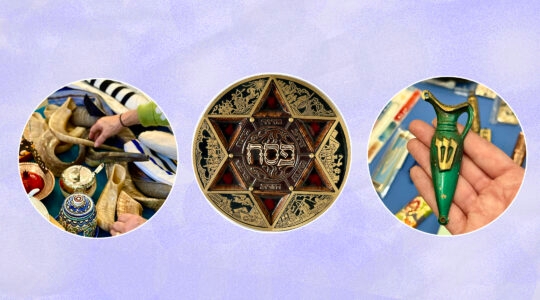NEW YORK (JTA) — Much has been written and said of late about the underground white supremacist subculture in which Wisconsin shooter Wade Page immersed himself, and his own involvement with white power music. But one aspect of that subculture has not been given the attention it deserves. In that subculture, there also is a powerful undercurrent of anti-Semitism.
The anti-Semitism is unmistakable in band names such as Jew Slaughter, Final Solution and Ethnic Cleansing. The latter boasts of albums called “Piles of Dead Jews” and “Hitler was Right.”
Another longstanding white supremacist band, Bully Boys, has recorded songs called “Fire Up the Ovens” and “Six Million More.” In the first one, the group sings about leaving “no stone unturned until the last Jew burns.” And in “Six Million More,” they sing:
“They’re on the media night and day looking for our sympathy
Yeah the Holocaust, the crystal night don’t mean a thing to me
No, the world can’t take much more of this Zionist intervention
The only fool proof plan is mass extermination.”
These bands and others like them are part of a thriving subculture; some white supremacists drive for hundreds of miles to attend their concerts. Their fans gather together, many sporting shaved heads and covered with tattoos. The men pump their fists in the air and dance raucously in front of a stage festooned with Nazi flags and racist skinhead symbols, while others, including a few women, watch around the perimeter. Onstage, the music is deafening, urging white people “to stand up and fight.”
Apart from the concerts, which rarely attract crowds of more than a couple hundred, the music reaches others who purchase or download it from the Internet. Since white power music arrived in the United States in the late 1970s, it has become a pillar of the subculture permeating the white supremacist movement.
The music comes in many flavors. The oldest is a racist form of Oi!, associated with the original skinhead subculture in Great Britain. Also popular is hatecore, a white supremacist version of hardcore punk. A white supremacist form of death metal music, known as National Socialist Black Metal Music, or NSBM, has become popular. There are other small subgenres of hate music — even a few white power hip-hop artists, though most white supremacists dislike hip hop.
At any given time, about 100 to 150 white power bands are active in the United States. The bands’ own names defiantly express feelings of hate or violence: examples other than those mentioned previously include Aggravated Assault, Angry Aryans, Attack, Definite Hate, Force Fed Hate, Fueled by Hate and Hate Crime. Most of these bands are the white supremacist equivalents of garage bands — nobody is getting rich from the music. Behind them are small record labels or distributors that specialize in white power music such as Label 56, Tightrope Records, Final Stand Records and others.
Many bands are associated with racist skinhead groups such as Volksfront, the Vinlanders Social Club or, especially, the Hammerskins, who dominate much of the white power music scene. Many bands are Hammerskins-affiliated, while the group itself organizes hate music concerts, including Hammerfest, its largest annual event.
White power music conveys many messages. Obviously it conveys hatred: antagonism toward Jews, immigrants, nonwhites, Muslims, gays and left-wingers. But songs can convey other messages, too. Some white power songs may glorify heroes or martyrs of the white supremacist movement. Some are essentially self-promotional, praising a group or leader.
Songs that urge or celebrate generic violence also are common, emerging from a subculture in which violence is easily condoned. A number of songs attempt to convey some sense of commonality, to strengthen the sense that listeners are in a movement with shared ideas, goals — or perceived enemies such as Jews.
What are the effects of white power music? It’s often hard to know exactly how music of any kind may affect someone. Music is universally acknowledged as powerful, yet its effects are often indirect.
Hate music does sometimes create direct effects. Incidents of hate crimes being committed by people who had just been at a hate music event have been reported. More indirectly, hate music certainly contributes to the shared ideas and notions of the white supremacist movement, including its willing acceptance of violence.
Not only was Wade Page, the white supremacist responsible for the massacre at a Sikh temple in Wisconsin, part of this subculture, he also was a performer. A racist skinhead himself, he played in two white power music bands, End Apathy and Definite Hate, affiliated with the Hammerskins.
The recent tragedy should be a wake-up call for all of us, including the Jewish community. It is important for us to be concerned about this subculture that celebrates hateful music, hateful lyrics, and messages of hate and anti-Semitism. Our concerns should be heightened by the reminder we have just received that this hate does sometimes lead to violence and murder, including occasions when Jewish individuals and Jewish institutions have been targeted.
For example, in 1999 white supremacist Buford Furrow went after children at the Los Angeles JCC. Three years ago, another white supremacist, James von Brunn, targeted the U.S. Holocaust Memorial Museum in Washington, D.C., murdering a museum guard. In April 2011, two white supremacists assaulted and seriously injured a Jewish man in Southern California, and last December, white supremacist Danny Lee Warner reportedly told his wife that he was setting out to kill as many Jews as possible. Fortunately, in the Warner case, he was apprehended before he could carry out his plan.
What can be done about this subculture of hate and the violence it seems to beget? One solution is to shine a light on the hateful lyrics and music, as ADL does, so that more people will speak out and reject their disturbing and sometimes violent message.
(Mark Pitcavage is director of investigative research of the Anti-Defamation League.)
JTA has documented Jewish history in real-time for over a century. Keep our journalism strong by joining us in supporting independent, award-winning reporting.





